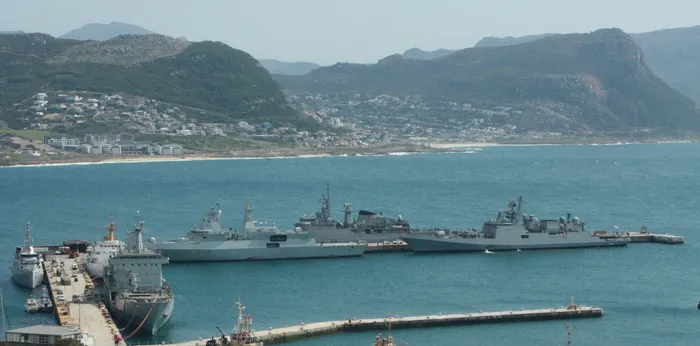Urgent review of navy’s role and its assets required

Simon’s Town harbour last week. The SAS Amatola and the Indian frigate Talwar are on the inside of the berth, while the Brazilian frigate Defensora is at the outer wall. All three vessels are participating in the IBSAMAR VIII exercises in False Bay and off the west coast. Picture: Brian Ingpen
Ten days ago, thousands flocked to Simon’s Town for the Navy Festival for which a Russian frigate and a support ship were in port.
While earlier announcements of ambitious foreign voyages by Naval vessels might have led some to believe that our Grey Funnel Line is shipshape, the supposedly Cuba-bound Drakensberg has been in port for years, hardly good preparation for taxing long-distance voyages. Recent references to inferior maintenance of ships are also extremely concerning.
Although current exercises with Brazilian and Indian warships will help to train local officers and ratings, regular sea time in busy shipping lanes, launching and recovering fast craft, helicopter operations, search and rescue exercises, and refuelling at sea provide ideal training for watchkeepers, ops room teams, engineers and others on board.
A retired senior naval officer with years of seagoing experience related his excitement at gaining valuable ship-handling experience while bringing the frigate President Steyn abeam of Tafelberg for ship-to-ship refuelling exercises at sea.
“I was a relatively junior officer aboard the frigate,” he enthused. “Sam [the OC] watched me bring [President] Steyn abeam at close quarters and then clear the replenishment vessel a few times. Then he went below for lunch, leaving me to do it on my own!”

With Drakensberg languishing in port, such exercises will have to wait to test officers’ mettle in manoeuvring vessels at close quarters for ship-to-ship refuelling – unless visiting replenishment ships fill the gap.
With no maritime threat to South Africa and with the country declaring its “neutrality” – its actions and pronouncements show a different stance - the navy’s role and the assets required to fulfil that role need urgent review.
An obvious consideration is the country’s important geo-political position on a major trade route that, under normal conditions, carries more traffic than the Suez Canal – and the Cape route is the current alternative to the dangerous Red Sea route. Although South Africa has an international responsibility to monitor shipping in the vast southern maritime area, with its present naval assets, the country cannot meet that obligation. Neither can it protect the Cape route.
Instead, the navy should address at least medium-term concerns. This column often advocates boosting the following essential roles of the navy, each requiring careful planning, specialised assets and thorough training:
- Search and rescue operations, given the busy shipping lane off the coast, notorious for wild sea conditions, and crowded with diverted vessels, including some carrying thousands of passengers and crew; (Miraculously, only one small vessel has been lost during this time of abnormally heavy traffic and adverse weather.)
- Anti-piracy operations, usually in the Mozambique Channel, but extended to prevent incursions by IS and similar terrorists. (Apparently, the frigate Amatola will undertake that role shortly, but technical challenges often interrupt such deployments.)
- Anti-smuggling operations to curb the current flow of drugs into the region. (Properly coordinated coastal patrols will also counter trafficking of weapons and people.)
- Anti-poaching measures to tackle crime syndicates and foreign fishing vessels, operating with apparent impunity in some areas.
To fulfil these roles properly, extensive maritime surveillance operations are absolutely essential, for which the air force will need a squadron of specialised long-range aircraft and, based in each port, two maritime helicopters. (Civilian helicopters could operate under a similar contract to that of the salvage tug.) Carrying well-trained response units, the current frigate flotilla and new inshore patrol vessels can support those vital aerial operations.
And the money for these ideas? Some funds – admittedly not all – can be gleaned by selling the submarines that are unnecessary to the future needs the navy and are a drag on naval expenditure and training systems. Scrap all obsolete vessels, and, to the highest bidders (not to loyal cadres) sell unused and derelict land and buildings under naval control, including disgracefully neglected tennis courts in Simon’s Town, a symptom of general malaise within the navy.
Apparently, personnel reduction is underway in the navy that is laden with expensive flag officers and other brass (some with little expertise to enhance proper naval operations), while further cutbacks among the decorative side of the navy should follow.
Non-negotiable, however, is the need for thoroughly intensive training in navigation, weapons-technology and operation, electronics and engineering, including substantial sea time. Also imperative is boosting the naval dockyard capacity to maintain and modify ships as required – or to contract competent, experienced marine engineering firms to meet that need.
The Cape route will remain busy, perhaps for years. Emboldened Iran-backed Houthi rebels will continue their attacks on Red Sea shipping. If a real fire-fight between Israel and Iran occurs, oil prices (and therefore bunker prices) will soar, as will insurance premiums on vessels on Middle Eastern trades. Despite the presence of warships in the area, only irresponsible owners – including tanker owners clandestinely moving Russian oil - will send ships through volatile hotspots.
Indeed, leading containership operators have geared their operations to use the Cape route at least for the next six months.
With great trepidation, the world watches the Middle East cauldron, and the US as voting day looms!
brian@capeports.co.za
Cape Times